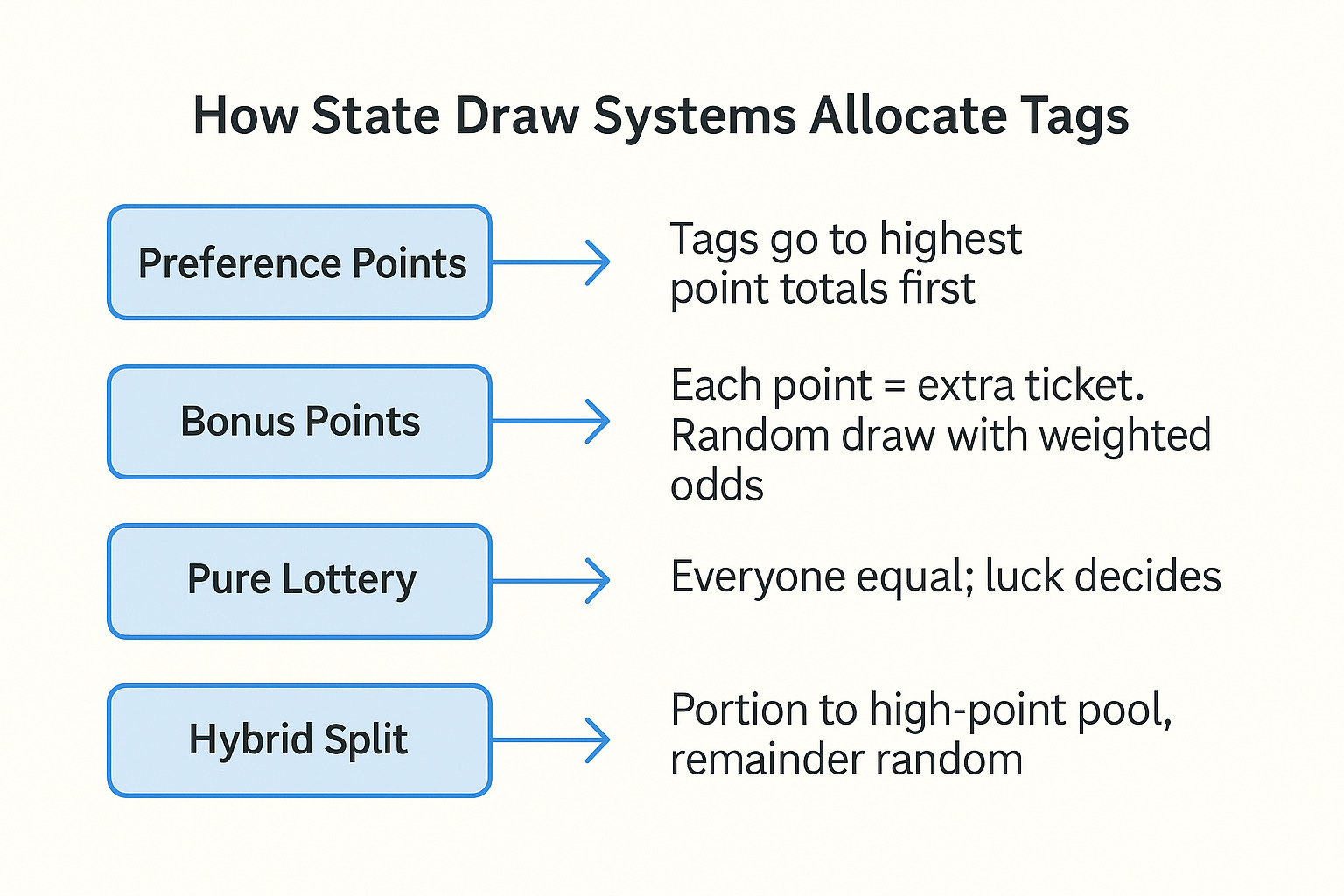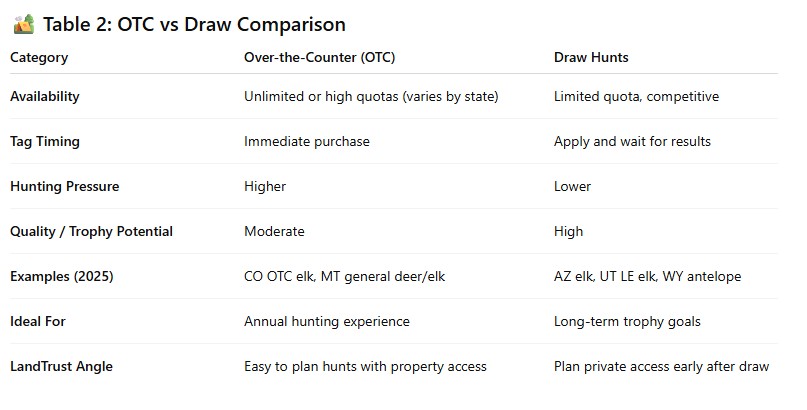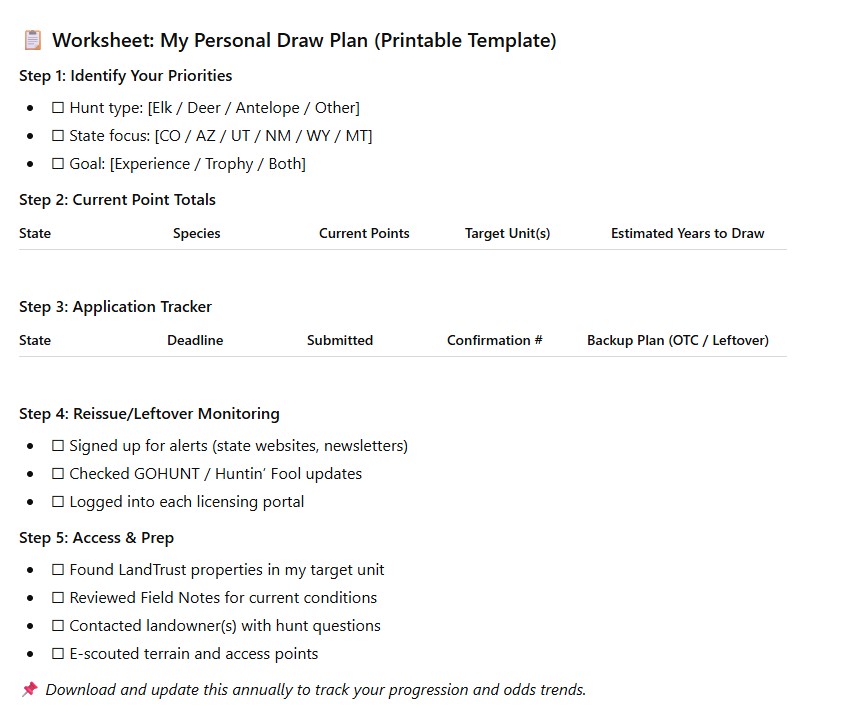How to Navigate State Draw Systems and Improve Tag Odds (2025 Guide)
Introduction: The Odds Aren’t Getting Better—But Your Strategy Can Be
Every hunter knows the feeling—waiting on that email that decides your season. With tag demand rising across the West, success isn’t about luck anymore—it’s about understanding how each state draw system works and learning how to improve your hunting tag draw odds through smart planning.
In this guide, we’ll break down how hunting draws work, what preference points vs. bonus points really mean, how to avoid point creep, and the exact levers you can pull to tip the odds in your favor this year—and for years to come.
And when you finally draw (or pick up an OTC tag), LandTrust is your partner in making the most of it—giving you access to private land, clear rules, insurance-backed safety, and real-time Field Notes from landowners who know their ground better than anyone.
How State Draw Systems Work (At a Glance)
Understanding how states allocate tags is the foundation of draw success. Each system rewards participation differently—and knowing those mechanics determines your best strategy.
1. Preference Points
- How it works: Tags go first to hunters with the most accumulated points.
- Examples: Colorado (for many limited hunts), Wyoming (NR deer/elk).
- Pros: Predictable—more points = better odds.
- Cons: “Point creep” can push dream hunts further out each year.
2. Bonus Points
- How it works: Points act as extra “tickets” in the drawing—still random, but weighted.
- Examples: Arizona, Utah.
- Pros: Everyone technically has a chance.
Cons: Long odds still stay long for high-demand hunts.
3. Pure Lottery Systems
- How it works: No points, no history—every applicant starts fresh.
- Example: New Mexico.
- Pros: Level playing field.
- Cons: No long-term advantage or planning leverage.
4. Hybrids and Modified Systems
Some states split allocations—part go to high-point holders, the rest remain random.
- Examples: Arizona (20% pass to highest points), Utah (bonus points + random pool).

Key Levers to Improve Your Odds (What Actually Moves the Needle)
If you can’t change the system, you can still change your strategy. Here’s what matters most:
Choice Ordering
Your first-choice unit should be realistic, not just a dream pick. Many states only consider your first choice before moving on. Use second–fourth choices strategically for mid-tier or undersubscribed units.
Party Applications
Group apps can help—or hurt.
- Pros: Keeps you hunting together.
- Cons: Most states average or drop to the lowest point level (e.g., Colorado, Wyoming).
Be sure everyone’s points align, or you’ll lower the group’s odds.
Unit Filtering
Use draw odds tools (GOHUNT, Huntin’ Fool) to find “opportunity” units.
- Try weapon pivots (archery/muzzleloader often easier).
- Shift to less crowded seasons or zones.
Point Creep Management
Instead of chasing top-tier units, target rising but attainable hunts. Rotate species, hunt every few years, and use youth or mentor pathways when eligible.
Returned, Reissued & Leftover Tags
Many hunters overlook these. Watch Colorado’s Reissue List, Arizona’s first-come leftovers, or Wyoming’s leftover draws.
- Sign up for newsletters or set calendar alerts.
- Be logged in and ready when reissue windows open.
OTC vs. Draw Portfolio
Balance your year:
- OTC/general hunts keep you in the field every season.
- Draw hunts build long-term trophy goals.

State-by-State Quick Guide (2025)
Here’s a snapshot of how six key Western states run their draws, what levers you can pull, and when to act.

Colorado (CPW)
- System: Preference points for most limited hunts; OTC elk/deer available.
- Draw Deadline: March (Primary Draw).
- Quick Tip: Use leftover and reissue lists; expect point system changes by 2028.
Arizona (AZGFD)
- System: Bonus points; 20% of tags go to highest-point pool.
- Draw Deadline: February.
- Quick Tip: Mix your first and second choices; late hunts often hold better odds.
Utah (UT DWR)
- System: Bonus for LE hunts; preference for general deer.
- Draw Deadline: Early March.
- Quick Tip: Spike elk and general deer builds experience and points simultaneously.
New Mexico (NMDGF)
- System: Pure lottery, no points.
- Draw Deadline: Mid-March.
- Quick Tip: Apply every year; group apps can slightly improve odds.
Wyoming (WGFD)
- System: Preference for NR elk/deer/antelope.
- Draw Deadline: January (elk), May (deer/antelope).
- Quick Tip: “Special” draw increases odds slightly—for a price.
Montana (FWP)
- System: Preference for NR combos; bonus for LE permits.
- Draw Deadline: April.
- Quick Tip: Apply early; leftover combo tags can reopen in August.
Tools, Calculators, and Data Sources
Knowing your odds is power. Use these tools smartly:
- GOHUNT Draw Odds: Filter by state, weapon, and residency.
- State .gov Dashboards: Reliable for historical odds and quota shifts.
- Huntin’ Fool & onX Hunt: Great for trendlines and terrain insights.

Point Creep: What It Is and How to Beat It
Point creep happens when more high-point hunters apply for a limited number of tags than there are tags available.
Example: Last year, a hunt took 6 points to draw. This year, it takes 7—because more high-point hunters applied than spots available.
How to Manage It
- Target mid-tier units that move slowly.
- Pivot to less popular weapons or seasons.
- Hunt alternate species (e.g., pronghorn) while banking elk points.
- Track trends with GOHUNT or state reports annually.
Leftover, Returned, and Reissued Tags: Quick Wins
Some of the best opportunities drop quietly after the main draw.
How It Works
- Colorado: Weekly reissue list updates.
- Arizona: Leftover list + first-come, first-served.
- Wyoming/Montana: Leftover draws; reissues through official portals.
Your Checklist
- Save official leftover page URLs.
- Sign up for agency alerts.
- Have account info and payment details ready.
- Move fast—these windows close in minutes.

After You Draw: Maximize Your Success
Drawing the tag is only half the win. Make the most of it with LandTrust.
1. Secure Private-Land Access
Find vetted LandTrust properties in your draw unit for safe, insured access.
2. Prepare with Field Notes
Check recent landowner updates on wildlife movement, access roads, and weather.
3. E-Scout and Communicate Early
Use maps, confirm boundaries, and message landowners about retrieval policies.
4. Stay Ethical & Safe
Follow tagging and blaze orange laws, respect private boundaries, and leave gates as you found them.
FAQs: Quick Answers for Draw Season 2025
Q: What’s the difference between preference points and bonus points?
A: Preference points rank applicants by seniority; bonus points give weighted odds but remain random.
Q: How do party applications affect draw odds?
A: Most states average or drop to the lowest-point level—so mix groups carefully.
Q: What are the 2025 application deadlines by state?
A: Colorado (Mar), Arizona (Feb), Utah (Mar), New Mexico (Mar), Wyoming (Jan/May), Montana (Apr).
Q: What are leftover and reissued tags, and how do I get them?
A: Watch official state lists post-draw, sign up for alerts, and act fast when windows open.
Q: Which states still offer OTC elk tags?
A: Colorado, Idaho, and Montana have general or OTC elk options—though availability changes yearly.
Q: How do I calculate draw odds and reduce point creep risk?
A: Use state calculators or GOHUNT’s Draw Odds tool; target mid-tier units instead of chasing top-tier creep zones.
Conclusion: Control the Controllables
You can’t change the odds—but you can change how you play them.
Master your state’s system, apply smart, and plan for both annual opportunity and long-term goals.
When that “successful” email lands in your inbox, LandTrust helps you turn that tag into a memorable, ethical, and safe hunt on private ground.
